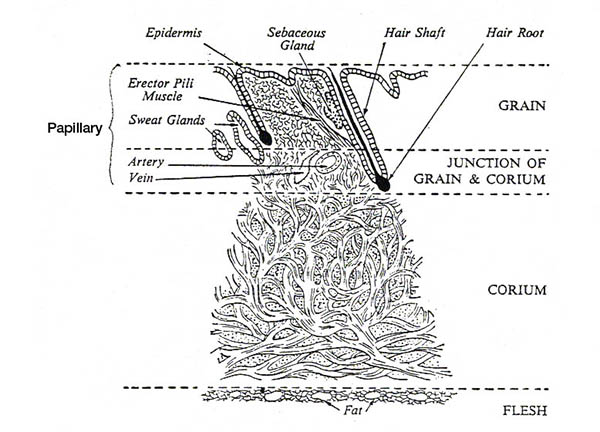SKIN STRUCTURE
Mammalian skin is an organ fulfilling many physiological functions such as regulation of body temperature, storage of body requirements, protection, elimination of waste products, sensory detection and communication. Age, sex, diet, environment, stress and state of health reflect itself.Fresh hides consist of water, protein, fatty materials and some mineral salts.
The most important for leather making is the protein. This protein may consist of many types: Collagen- on tanning gives leather; keratin- constituent of hair, wool, horn and epidermal structures.
Approximate composition of a freshly-flayed hide:
Water 64 %
Protein 33 % (structural proteins and non-structural proteins)
Structural proteins:
……Elastin 0.3 %
……Collagen 29 %
……Keratin 2 %
Non-Structural proteins:
……Albumins, Globulins 1 %
Albumins are soluble in water and dilute salt solutions,acids and alkali. Coagulates by heat; Globulins are insoluble in water but dissolve in salt solutions of moderate concentrations. They are insoluble in strong salt solutions and coagulate by heat.
Mucins, Mucoids 0.7 %
Fats 2 %
Mineral salts 0.5 %
Other substances 0.5 % (pigments, etc.)
Starting on the hair side (a cross section of the skin):

a) The hairs- each in a hair follicle with a hair root at its end, fed by a tiny blood vessel. Hair consist of protein keratin.
b) Epidermis- the interface between the delicate tissues within a body and the hostile universe. A protective layer of keratinous cells. Keratin gives the skin considerable mechanical strength and flexibility. It is quite insoluble and serves to waterproof the body surface. It is readily attacked by bacteria, easily disintegrated by alkalis, such as caustic soda, lime and sodium sulphide or hydrosulphide. This is the basis of the unhairing process in the limeyard when the lime and the sulphide destroy hair roots and soft underside of the epidermis.
c) Sweat glands- discharge sweat through the pores of the grain
d) Sebaceous glands- at side of hair follicles, discharge a waxy oily substance to protect hair.
 e) Corium- network of collagen fibers. Strongest part of the skin. Towards the center, fibers are coarser and stronger. Predominant angle at which they are woven can indicate properties of leather. If fibers are more upright and tightly woven, a firm hard leather with little stretch is expected. If they are horizontal and loosely woven, a soft strechier leather is expected.
e) Corium- network of collagen fibers. Strongest part of the skin. Towards the center, fibers are coarser and stronger. Predominant angle at which they are woven can indicate properties of leather. If fibers are more upright and tightly woven, a firm hard leather with little stretch is expected. If they are horizontal and loosely woven, a soft strechier leather is expected.
f) Flesh- next to the meat, fibres are more horizontal, fatty (or adipose) tissue may also be present.
In living skin, all these collagen fibers and cells are in a watery jelly of protein-like structure. The living collagen fibers are formed from this substance, which consequently ranges in constitution from the blood sugars to substances which are almost collagen- inter fibrillary proteins also known as pro-collagen or non-structural proteins. When dried, they convert to glue like material and harden the skin. In making leather, which is to be soft or supple, it is important to remove these interfibrillary proteins.
Excessive growth of fat cells weakens the corium fiber structure.
Corium fibers are composed of rope-like bundles of smaller fibrils which consist of bundles of sub-microscopic micelles. These in turn are made of very long, thread like molecules of collagen twisted together. This gives a very strong, tough, flexible structure.

